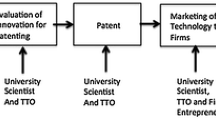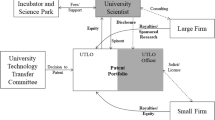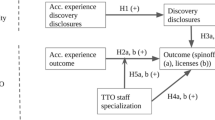Abstract
Many universities engage in academic entrepreneurship, often with funding from external sources. Benchmarking technology transfer performance with external research funding can help universities identify and learn from peers that may possess strategic advantages in productivity. It also can be key for organizational learning and for communicating organizational performance to policy stakeholders and industry partners. In this study, we construct a unique dataset by linking two important data sources, AUTM and UMETRICS, and use stochastic frontier analysis to benchmark university licensing and revenue performance with different federal funding streams. Our empirical results suggest that universities looking to promote commercialization performance might look to National Science Foundation funding, and the universities best at production (i.e., licensing technologies and generating patents) with external funding are not necessarily the best at capturing benefits from generating revenue from entrepreneurial activity and launching start-ups. Our study points to the importance of the differential advantages of sources of federal research funding and offers implications for policy makers and university administrators.
Similar content being viewed by others
Data availability
UMETRICS Citation: The Institute for Research on Innovation & Science (IRIS). Summary Documentation for the IRIS UMETRICS 2019 Data Release. Ann Arbor, MI: IRIS [distributor], 2019–05-10, https://doi.org/10.21987/a07t-1c72. Association of University Technology Managers. (2016). AUTM, Association of University Technology Managers. Norwalk, CT:AUTM,
References
Abramo, G., D’Angelo, C. A., Di Costa, F., & Solazzi, M. (2009). University–industry collaboration in Italy: A bibliometric examination. Technovation, 29(6–7), 498–507.
Allen, B. M., Lane, J. I., Rosen, R., Smith, J. O., & Weinberg, B. A. (2015). UMETRICS as a tool for quantifying the value of research and assessing underrepresentation. Feature, Association for Women in Science, 36–39.
Ammons, D. N. (1999). A proper mentality for benchmarking. Public Administration Review, 59, 105–109.
Ammons, D. N., & Roenigk, D. J. (2015). Benchmarking and interorganizational learning in local government. Journal of Public Administration Research and Theory, 25(1), 309–335.
Ankrah, S. N., Burgess, T. F., Grimshaw, P., & Shaw, N. E. (2013). Asking both university and industry actors about their engagement in knowledge transfer: What single-group studies of motives omit. Technovation, 33(2–3), 50–65.
Arora, A., & Gambardella, A. (2005). The impact of NSF support for basic research in economics. Annales d'Economie et de Statistique, 80, 91–117.
Arora, S. K., Li, Y., Youtie, J., & Shapira, P. (2019). Measuring dynamic capabilities in new ventures: Exploring strategic change in US green goods manufacturing using website data. The Journal of Technology Transfer, 45(5), 1451–1480.
Auranen, O., & Nieminen, M. (2010). University research funding and publication performance—An international comparison. Research Policy, 39(6), 822–834.
Barbieri, E., Rubini, L., Pollio, C., & Micozzi, A. (2018). What are the trade-offs of academic entrepreneurship? An investigation on the Italian case. The Journal of Technology Transfer, 43(1), 198–221.
Barnum, D., Coupet, J., Gleason, J., McWilliams, A., & Parhankangas, A. (2017). Impact of input substitution and output transformation on data envelopment analysis decisions. Applied Economics, 49(15), 1543–1556.
Battese, G. E., & Coelli, T. J. (1992). Frontier production functions, technical efficiency and panel data: With application to paddy farmers in India. Journal of Productivity Analysis, 3(1–2), 153–169.
Battese, G. E., & Coelli, T. J. (1995). A model for technical inefficiency effects in a stochastic frontier production function for panel data. Empirical Economics, 20(2), 325–332.
Belitski, M., Aginskaja, A., & Marozau, R. (2019). Commercializing university research in transition economies: Technology transfer offices or direct industrial funding? Research Policy, 48(3), 601–615.
Bellini, E., Piroli, G., & Pennacchio, L. (2019). Collaborative know-how and trust in university–industry collaborations: Empirical evidence from ICT firms. The Journal of Technology Transfer, 44(6), 1939–1963.
Belotti, F., Daidone, S., Atella, V., & Ilardi, G. (2015). SFPANEL: Stata module for panel data stochastic frontier models estimation.
Berbegal-Mirabent, J., García, J. L. S., & Ribeiro-Soriano, D. E. (2015). University–industry partnerships for the provision of R&D services. Journal of Business Research, 68(7), 1407–1413.
Bikard, M., Vakili, K., & Teodoridis, F. (2019). When collaboration bridges institutions: The impact of university–industry collaboration on academic productivity. Organization Science, 30(2), 426–445.
Blume-Kohout, M. E., Kumar, K. B., Lau, C., & Sood, N. (2015). The effect of federal research funding on formation of university-firm biopharmaceutical alliances. The Journal of Technology Transfer, 40(5), 859–876.
Bozeman, B., & Boardman, C. (2004). The NSF engineering research centers and the university–industry research revolution: A brief history featuring an interview with Erich Bloch. The Journal of Technology Transfer, 29(3–4), 365–375.
Bozeman, B., Rimes, H., & Youtie, J. (2015). The evolving state-of-the-art in technology transfer research: Revisiting the contingent effectiveness model. Research Policy, 44(1), 34–49.
Buffington, C., Cerf, B., Jones, C., & Weinberg, B. A. (2016). STEM training and early career outcomes of female and male graduate students: Evidence from UMETRICS data linked to the 2010 census. American Economic Review, 106(5), 333–338.
Chang, W. Y., Cheng, W., Lane, J., & Weinberg, B. (2019). Federal funding of doctoral recipients: What can be learned from linked data. Research Policy, 48(6), 1487–1492.
Chapple, W., Lockett, A., Siegel, D., & Wright, M. (2005). Assessing the relative performance of UK university technology transfer offices: Parametric and non-parametric evidence. Research Policy, 34(3), 369–384.
Coccia, M. (2008). Science, funding and economic growth: analysis and science policy implications. World Review of Science, Technology and Sustainable Development, 5(1), 1–27.
Coccia, M., & Bozeman, B. (2016). Allometric models to measure and analyze the evolution of international research collaboration. Scientometrics, 108(3), 1065-1084.
Cohen, W. M., Nelson, R. R., & Walsh, J. P. (2002). Links and impacts: The influence of public research on industrial R&D. Management Science, 48(1), 1–23.
Coupe, T. (2003). Science is golden: Academic R&D and university patents. The Journal of Technology Transfer, 28(1), 31–46.
Coupet, J., & Berrett, J. L. (2019). Toward a valid approach to nonprofit efficiency measurement. Nonprofit Management and Leadership, 29(3), 299–320.
Crișan, E. L., Salanță, I. I., Beleiu, I. N., Bordean, O. N., & Bunduchi, R. (2019). A systematic literature review on accelerators. The Journal of Technology Transfer, 46, 62–89.
De Wit-de Vries, E., Dolfsma, W. A., van der Windt, H. J., & Gerkema, M. P. (2019). Knowledge transfer in university–industry research partnerships: A review. The Journal of Technology Transfer, 44(4), 1236–1255.
Eesley, C. E., & Miller, W. F. (2017). Impact: Stanford university's economic impact via innovation and entrepreneurship. Available at SSRN 2227460.
Friedman, J., & Silberman, J. (2003). University technology transfer: Do incentives, management, and location matter? The Journal of Technology Transfer, 28(1), 17–30.
Gardner, S. K., & Veliz, D. (2014). Evincing the ratchet: A thematic analysis of the promotion and tenure guidelines at a striving university. The Review of Higher Education, 38(1), 105–132.
Greene, W. (2005). Reconsidering heterogeneity in panel data estimators of the stochastic frontier model. Journal of Econometrics, 126(2), 269–303.
Grimaldi, R., Kenney, M., Siegel, D. S., & Wright, M. (2011). 30 years after Bayh–Dole: Reassessing academic entrepreneurship. Research Policy, 40(8), 1045–1057.
Hayter, C. S., Rasmussen, E., & Rooksby, J. H. (2020). Beyond formal university technology transfer: innovative pathways for knowledge exchange. The Journal of Technology Transfer, 45(1), 1–8.
Heher, A. D. (2006). Return on investment in innovation: Implications for institutions and national agencies. The Journal of Technology Transfer, 31(4), 403–414.
Heisey, P. W., & Adelman, S. W. (2011). Research expenditures, technology transfer activity, and university licensing revenue. The Journal of Technology Transfer, 36(1), 38–60.
Jacob, B. A., & Lefgren, L. (2011). The impact of research grant funding on scientific productivity. Journal of Public Economics, 95(9–10), 1168–1177.
Jefferson, D. J., Maida, M., Farkas, A., Alandete-Saez, M., & Bennett, A. B. (2017). Technology transfer in the Americas: Common and divergent practices among major research universities and public sector institutions. The Journal of Technology Transfer, 42(6), 1307–1333.
Kim, Y. (2013). The ivory tower approach to entrepreneurial linkage: Productivity changes in university technology transfer. The Journal of Technology Transfer, 38(2), 180-197.
Kim, J., & Daim, T. U. (2014). A new approach to measuring time-lags in technology licensing: Study of US academic research institutions. The Journal of Technology Transfer, 39(5), 748–773.
Klein, R., de Haan, U., & Goldberg, A. I. (2010). Overcoming obstacles encountered on the way to commercialize university IP. The Journal of Technology Transfer, 35(6), 671–679.
Kumbhakar, S. C., & Lovell, C. K. (2003). Stochastic frontier analysis. . Cambridge University Press.
Lafuente, E., & Berbegal-Mirabent, J. (2019). Assessing the productivity of technology transfer offices: An analysis of the relevance of aspiration performance and portfolio complexity. The Journal of Technology Transfer, 44(3), 778–801.
Lane, J. I., Owen-Smith, J., Rosen, R. F., & Weinberg, B. A. (2015). New linked data on research investments: Scientific workforce, productivity, and public value. Research Policy, 44(9), 1659–1671.
Lin, M. W., & Bozeman, B. (2006). Researchers’ industry experience and productivity in university–industry research centers: A “scientific and technical human capital” explanation. The Journal of Technology Transfer, 31(2), 269–290.
Lindelöf, P., & Löfsten, H. (2004). Proximity as a resource base for competitive advantage: University–industry links for technology transfer. The Journal of Technology Transfer, 29(3–4), 311–326.
Link, A. N., Siegel, D. S., & Van Fleet, D. D. (2011). Public science and public innovation: Assessing the relationship between patenting at US National Laboratories and the Bayh-Dole Act. Research Policy, 40(8), 1094–1099.
López-Bermúdez, B., Freire-Seoane, M. J., & Nieves-Martínez, D. J. (2019). Port efficiency in Argentina from 2012 to 2017: An ally for sustained economic growth. Utilities Policy, 61, 100976.
Lundquist, G. M. (1996). A key to the marketing of R&D. The Journal of Technology Transfer, 21(1–2), 12–15.
Mervis, J. (2006). NIH shrinks, NSF crawls as Congress finishes spending bills. In: American Association for the Advancement of Science.
Mervis, J. (2013). Congress Limits NSF Funding for Political Science. In: American Association for the Advancement of Science.
Mervis, J. (2014). Congress, NSF spar on access to grant files. In: American Association for the Advancement of Science.
Mowery, D. C., & Rosenberg, N. (1999). Paths of innovation: Technological change in 20th-century America. . Cambridge University Press.
O’Shea, R. P., Allen, T. J., Chevalier, A., & Roche, F. (2005). Entrepreneurial orientation, technology transfer and spinoff performance of US universities. Research Policy, 34(7), 994–1009.
Owen-Smith, J., & Powell, W. W. (2001). To patent or not: Faculty decisions and institutional success at technology transfer. The Journal of Technology Transfer, 26(1–2), 99–114.
Perko, J. S., & Narin, F. (1997). The transfer of public science to patented technology: A case study in agricultural science. The Journal of Technology Transfer, 22(3), 65–72.
Powell, W. W., Owen-Smith, J., & Colyvas, J. A. (2007). Innovaton and emulation: Lessons from American universities in selling private rights to public knowledge. Minerva, 45(2), 121–142.
Qureshi, S., & Mian, S. (2020). Transfer of entrepreneurship education best practices from business schools to engineering and technology institutions: Evidence from Pakistan. The Journal of Technology Transfer, 46, 366–392.
Ramos-Vielba, I., & Fernández-Esquinas, M. (2012). Beneath the tip of the iceberg: Exploring the multiple forms of university–industry linkages. Higher Education, 64(2), 237–265.
Reficco, E., & Gutiérrez, R. (2016). Organizational ambidexterity and the elusive quest for successful implementation of BoP ventures. Organization & Environment, 29(4), 461–485.
Ruggiero, J. (1996). On the measurement of technical efficiency in the public sector. European Journal of Operational Research, 90(3), 553–565.
Schmiemann, M., & Durvy, J.-N. (2003). New approaches to technology transfer from publicly funded research. The Journal of Technology Transfer, 28(1), 9–15.
Siegel, D. S., Waldman, D. A., Atwater, L. E., & Link, A. N. (2004). Toward a model of the effective transfer of scientific knowledge from academicians to practitioners: Qualitative evidence from the commercialization of university technologies. Journal of Engineering and Technology Management, 21(1–2), 115–142.
Siegel, D. S., Waldman, D., & Link, A. (2003). Assessing the impact of organizational practices on the relative productivity of university technology transfer offices: An exploratory study. Research Policy, 32(1), 27–48.
Sorensen, J. A. T., & Chambers, D. A. (2008). Evaluating academic technology transfer performance by how well access to knowledge is facilitated–defining an access metric. The Journal of Technology Transfer, 33(5), 534–547.
Spielman, D. J., & von Grebmer, K. (2006). Public–private partnerships in international agricultural research: An analysis of constraints. The Journal of Technology Transfer, 31(2), 291–300.
Stone, V. I. (2003). Systematic technology transfer: A case study in assistive technology. The Journal of Technology Transfer, 28(3–4), 319–332.
Swamidass, P. M. (2013). University startups as a commercialization alternative: Lessons from three contrasting case studies. The Journal of Technology Transfer, 38(6), 788–808.
Swamidass, P. M., & Vulasa, V. (2009). Why university inventions rarely produce income? Bottlenecks in university technology transfer. The Journal of Technology Transfer, 34(4), 343–363.
The Institute for Research on Innovation & Science (IRIS). (2019). UMETRICS 2019Q3a Dataset: Core Files. Ann Arbor, MI: IRIS [distributor]. https://doi.org/10.21987/R70080
Tornatzky, L. G. (2001). Benchmarking university–industry technology transfer: A six year retrospective. The Journal of Technology Transfer, 26(3), 269–277.
Wright, M., Vohora, A., & Lockett, A. (2004). The formation of high-tech university spinouts: The role of joint ventures and venture capital investors. The Journal of Technology Transfer, 29(3–4), 287–310.
Funding
This study was funded by the Institute for Research on Innovation and Science (IRIS) at the University of Michigan. Funding included access to the UMETRICS database.
Author information
Authors and Affiliations
Corresponding author
Ethics declarations
Conflicts of interest
The author that they declare no conflicts of interest.
Additional information
Publisher's Note
Springer Nature remains neutral with regard to jurisdictional claims in published maps and institutional affiliations.
Rights and permissions
About this article
Cite this article
Coupet, J., Ba, Y. Benchmarking university technology transfer performance with external research funding: a stochastic frontier analysis. J Technol Transf 47, 605–620 (2022). https://doi.org/10.1007/s10961-021-09856-3
Accepted:
Published:
Issue Date:
DOI: https://doi.org/10.1007/s10961-021-09856-3




